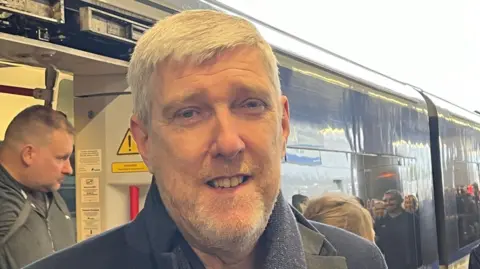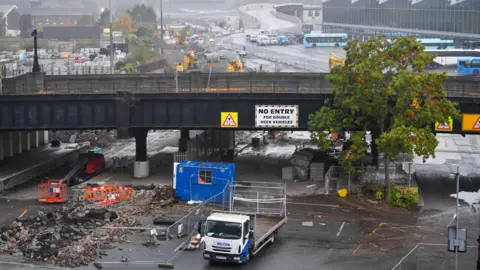Rail services begin at Belfast’s Grand Central Station

 BBC
BBC
Trains have started running from Belfast’s new £340m Grand Central Station.
The first departure was the 08.05 BST Enterprise service to Dublin Connolly Station.
It left on time with just over 100 passengers on board.
The railway line between Lisburn and Belfast had been closed for more than three months to connect train services to the new station.
Buses began operating from the new station five weeks ago but it took longer for safety authorities to give the green light to the new rail system.
The main public transport services in Belfast are now under one roof.


‘This is my treat’
Margaret McAllister, from Bangor, described rail services at the station as “absolutely brilliant”.
“A long time we’ve been waiting for it but sure it’s great,” she said.
Margaret travelled on the first train to leave the station.
“It’s my birthday tomorrow, so this is my treat, first class, to myself.”
It is billed by Translink as the “largest integrated travel hub on the island of Ireland” catering for up to 20 million passenger journeys a year.
There are eight railway platforms and 26 bus stands at the new transport hub.


‘A great day’
Chris Playfair, from south Belfast, was among the first passengers.
He describes himself as a “railway enthusiast”.
“I’ve had great interest in railways since I was a young child. My father worked in the railway for 44 years until he passed away last year,” Chris said.
“It’s a great day for history. It’s a great day for the community, and it’s nice to be part of it,” he added.


Infrastructure minister John O’Dowd was on board the first train to arrive at the new station, from Portadown, at 09.15.
“This is a hugely significant day for public transport,” the minister said.
“It’s about the future. It’s about saying to everyone out there we have a modern public transport system, and we encourage you to use it when you can,” he added.


Also onboard was Fiona McCrystal, from Dunmurry.
She said it was “historic moment” and that she “wanted to be part of it”.
Noah Hartin, 15, and his father Gavin, who are from Bushmills, left home at 06.25 to drive to Belfast in order to board the first train to leave the new station.
“It’s absolutely amazing. I find it overwhelming,” said Noah.


Land around the station is being redeveloped and there are plans to dismantle the nearby Boyne Bridge as part of the project.
Heritage campaigners trying to preserve the bridge failed in a last-minute legal attempt to stop work taking place.
The bridge was built in 1936 but has its origins in the 17th century at the time of William of Orange.
According to folklore, he rode over the bridge on his way to the Battle of the Boyne in 1690.
The road on which the bridge is situated, Durham Street, will be closed for the next year to facilitate the redevelopment.
Translink says the bridge will be “sensitively dismantled” with “key elements” preserved.
The opening of Grand Central Station last month has been blamed for an increase in traffic congestion in Belfast city centre.
The closure of Durham Street may add to the difficulties but the start of trains services means more people can opt for public transport.
‘Expect some delays’

 Pacemaker
Pacemaker
Translink has thanked the public for their patience during the recent transition period when the Belfast to Lisburn train line was closed and bus replacement services were in place.
A spokesperson for Translink said it was “encouraging people” to use public transport into Belfast as the next phase of works could cause “some delays” for road users.
“Translink would like to take this opportunity to thank the general public for their patience during these essential works.”
The transport hub has been built behind the previous bus and rail stations serving central Belfast, Europa bus centre and Great Victoria Street train station, which have now closed.
The new hub is equipped with more modern facilities and services, including more frequent cross-border trains to Dublin beginning later this month.
The hub is situated between the Sandy Row area of Belfast and Grosvenor Road.
Plans for the new integrated station date back more than a decade.








